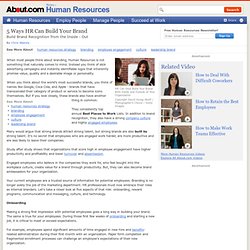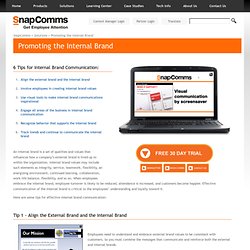

5 Ways HR Can Build Your Brand. When most people think about branding, Human Resources is not something that naturally comes to mind.

Instead you think of slick advertising campaigns and instantly identifiable logos that inherently promise value, quality and a desirable image or personality. When you think about the world’s most successful brands, you think of names like Google, Coca Cola, and Apple - brands that have transcended their category of product or service to become icons themselves. But if you look closely, these brands also have another thing in common.
They consistently top annual Best Places to Work Lists. In addition to brand recognition, they also have a strong company culture and highly engaged employees. Many would argue that strong brands attract strong talent, but strong brands are also built by strong talent. Study after study shows that organizations that score high in employee engagement have higher productivity and profitability and lower turnover and absenteeism. Onboarding Technology. Talent Management Lessons From Apple… A Case Study of the World’s Most Valuable Firm (Part 3 of 4) "Why join the Navy, if you can be a pirate? " Want to impress your CEO? Few CEOs wouldn’t mind having the innovation track record of Apple, so there is probably no quicker way to become an “instant hero” then by learning how Apple’s talent management practices have contributed to its success and applying those practices relevant to your organization.
In this installment of the case study, we’ll look at internal branding, employer branding, and recruiting. Internal Brand Encourages Fighting the Status Quo Steve Jobs and the management team at Apple have worked tirelessly to build a unique internal brand image at Apple that positions employees (at least mentally) as revolutionaries and rebels. Apple is well known for using T-shirts, parties, and celebrations to build cohesion and to reinforce the internal brand as a ragtag group of revolutionaries. You Can Have a Strong External Employer Brand Without an Employer Branding Program Being a Most-admired Firm May Be Enough. Internal brands – are they properly managed? Brands and Value Brands and branding have been major issues for businesses since the beginning of modern corporate life. Over a 200 year period the concept has moved from the logo on the side of a barrel or box, until they reached the emotional-psychological concept that they have come to represent today - and a valued, financially-tangible asset.
The evolution of brands – from consumer to employee When companies talk about their brands today it's often in terms like "loyalty", "commitment," "attachment," "needs," "feelings" and "aspirations". Until 20 years ago, such terms were reserved for consumers and were used to describe their relationship with the product. Since then, the concept of a brand has expanded from product and external image. At one time, these ideas might have been seen as some kind of management fashion – something that would fade away with time.
The focus of this article There are three key issues that this article addresses. Internal brands: three types 1. 2. 3. 4. 1. 3 Ways to Connect Employees to Your Company’s Brand « Communication at Work. One of the best purposes of employee communication is to help connect employees of your company to its brand and products, if it makes stuff. People who understand what their company does, what it stands for and what it makes are more likely to be engaged in the business and therefore commit more of their discretionary effort to it.
Besides, employees can be your brand’s best representatives out in the marketplace, in the community and among customers. Internal Brand Communication. 6 Tips for Internal Brand Communication: An internal brand is a set of qualities and values that influences how a company’s external brand is lived up to within the organization.

Internal brand values may include such elements as integrity, service, teamwork, flexibility, an energizing environment, continued learning, collaboration, work-life balance, flexibility, and so on. When employees embrace the internal brand, employee turnover is likely to be reduced, attendance is increased, and customers become happier. Satisfied Employees Become Your Brand Champions. City of Paris » Effective Internal Communications and Brand Management. By Donna Vetter The most challenging aspect of internal communications seems to be one of the easiest: engaging brand stakeholders with need-to-know information, when they need to know it.

The reality is, it’s not as easy as it sounds. No brand escapes the consequences of poor internal communications. And at no time is the need for internal communications more vital to brand success than during a crisis. Case in point: It was just post-launch for a brand that was to become the company’s most precious asset. The communication skills that enable us to win the hearts and minds of customers seem to abandon us when it comes to internal communications for a variety of reasons. No doubt the pressures on internal communications will only continue to intensify, and the need for more effective planning and management has never been greater. Internal marketing roadways.